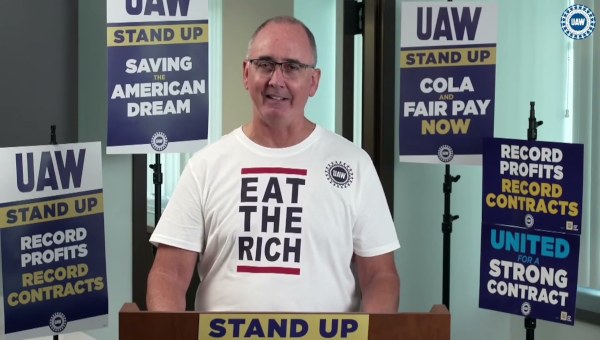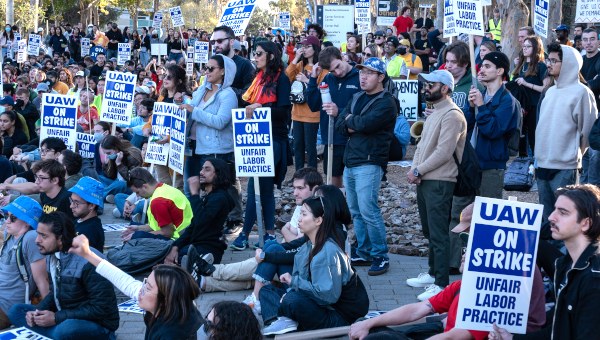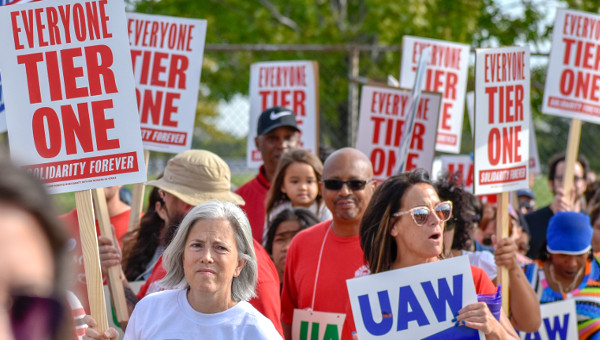UAW Rank-and-File Organize to Fight For Union Principles
For decades United Auto Workers (UAW) members at the Detroit Three – GM, Ford and Chrysler – were alleged to be narrowing their goals. Workers were said to be maintaining their living standards by ‘selling out their children’ – the new-hires in the plants. Votes on ratification of contracts backed by the UAW leadership were too ‘rigged’ so as to permit a ‘No’ vote. Decades of retreat under an increasingly isolated – even degenerating – leadership mocked basic union, and certainly socialist, standards.
These were just a few of the several arguments that were being made by many people inside and outside of the UAW on why the concessions contract being proposed by Ford to UAW members in October 2009 would soon be ratified. A parallel vote, on a different concessions contract for Canadian Auto Workers (CAW) members at Ford in Canada, was also being held virtually at the same time.
But if an acceptance vote for the contract was so predictable and the workers would just sheepishly go along with further concessions demands, one might wonder why radicals and socialists would organize among auto workers, even if the auto sector remains a key industry. This short article tells the story of the UAW Ford workers’ fightback against further concessions bargaining and how, in fact, the concessions contract was rejected.
The Auto Companies Push for Concessions
The financial crisis that erupted across the North American economy in mid-2007 revealed a range of management, organizational and financial problems of the auto companies. Like in the past, they came hunting for concessions from the UAW as the easy way to solve their troubles. The March 2009 Ford concessions and subsequent ratification vote seemed mainly to herald more of the same. The government-mandated ‘bankruptcy contracts’ at GM and Chrysler signed during the summer added to the vicious circle of concessions bargaining. They appeared to make even more Ford concessions inevitable: how could Ford workers afford to risk breaking from the concessions pattern?
 As expected, in October of this year enormous pressure came from the company and the government for concessions, and the UAW leadership agreed to follow the pattern of the other concessions – a pattern being set in Detroit Three plants in the U.S. and Canada. Ford workers in both Canada and the U.S. were threatened with further job loss if they did not vote for more concessions. Yet, by an almost 3-1 margin UAW members at Ford voted ‘No’ – at some key plants by over 90%.
As expected, in October of this year enormous pressure came from the company and the government for concessions, and the UAW leadership agreed to follow the pattern of the other concessions – a pattern being set in Detroit Three plants in the U.S. and Canada. Ford workers in both Canada and the U.S. were threatened with further job loss if they did not vote for more concessions. Yet, by an almost 3-1 margin UAW members at Ford voted ‘No’ – at some key plants by over 90%.
Making History
This vote was historic: it was the first time in the United States that a UAW-Detroit Three agreement had been voted down nationally. It was also historic on the Canadian side of the border: CAW workers at Ford accepted concessions, after enormous pressure from the CAW leadership, while UAW members rejected the contract. UAW-Ford members voted:
- to refuse to give up the right to strike over wages in 2011 (and possibly more broadly);
- to refuse to freeze new-hire pay (already cut in half in 2007, below average non-union industrial pay); and
- to stop eliminations of skilled trades.
These issues go beyond immediate dollars and cents and speak to union and class principles. The right to strike was the leading reason for voting ‘No.’ Current Ford workers halted for now the downward march of future workers’ wages. Protecting classifications was in trades’ workers immediate interest – but production workers supported them, and this was about control of the shop floor much more than wages.
Starting from Local 600’s Dearborn truck plant (part of the Rouge River complex), bargaining committeeperson Gary Walkowicz’s anti-concessions leadership expanded nationally. Truck plant workers shouted down UAW-Ford Vice President Bob King when he came to argue for a ‘Yes’ vote. Plant president Nick Kottalis and some other officers also opposed the contract. The truck plant voted 93% ‘No.’
Across all of UAW-Ford, dozens of rank and file workers wrote independent leaflets calling for a ‘No’ vote. During the balloting period, the Kansas City plant’s early, huge ‘No’ vote convinced other locals that the agreement could be defeated. Soon after national voting ended, that local voted to authorize a strike against overloaded jobs and health and safety violations. Such a vote is not uncommon in Kansas City, and the issues were settled without a strike. However, nation-wide ‘Strike Vote’ headlines reminded everyone that the UAW still has teeth that the rank and file could use to bite the company.
There were, however, some backward sentiments among ‘No’ voters: ‘We’ and ‘our company’ are superior to GM and Chrysler and ‘their’ workers. Some others saw the vote mainly as nationalist resistance to low-wages abroad. But overwhelmingly workers were fighting for progressive principles. UAW officials argued that since Ford workers have not struck nationally since 1976, the right-to-strike effectively no longer means anything. Workers replied: ‘If the right to strike doesn’t mean anything, then why does Ford want to take it away? We know it’s how we got what we have.’ The trigger for the ‘No’ vote was Ford’s demanding concessions once too often. But the ammunition was a consciousness broader and deeper amongst workers than almost anyone expected.
Principles in Reverse Gear
Even the Ford and UAW leaderships acknowledged that the fight was over principles. Officially distributed – but unsigned – leaflets argued that Ford workers must unselfishly vote ‘Yes’ to save our co-workers’ jobs. This argument flopped because decades of ‘job security contracts’ have not worked. Since 1979 overall UAW membership has dropped by over two-thirds. UAW-Detroit Three membership loss is worse. Only a union fighting for its members and for workers as a whole can organize the ‘foreign’ auto transplants and attract new members.
Even stranger was another UAW leadership ‘principled’ argument – the bizarre ‘defense of pattern bargaining’ (an argument successfully deployed by CAW for Ford workers in Canada). GM and Chrysler workers were forced to take concessions by the companies, the Obama Administration and the bankruptcy overseers. Therefore, Ford workers had to catch up – in the race to the bottom! If your neighbors’ house is on fire, then you should not help put out their fire, but put a match to your own house?
Years ago UAW officials argued that they bargain with GM over wages and with Ford to establish principles. This time Ford proposed ‘principles’ of its own. Freezing new hire pay would save Ford little short-term with few new hires likely. But a freeze would move toward cutting all wages in half over time. And eliminating the trades classifications is more about power on the shop floor than immediate wage rates. As for the right to strike, Ford did not look so much for immediate economic gain as for destruction of the UAW’s political as well as economic power. This point was made by a leaflet signed by workers from several different Local 600 production and skilled units:
“The strike threat defends our money, benefits, rights – and UAW political clout… Power in Washington starts with our power right here (for true national health insurance, converting closed plants to greener jobs and alternative transportation for auto and other workers, and defending the gains of civil rights movements, etc.).”
Workers came to see themselves in a power struggle beyond tomorrow’s wages or abstract words on a page. An article on the web site of Solidarity-U.S. concluded:
“For activists at Ford, the way forward is upward but not yet entirely clear in its details. The vote was notably dependent on a ‘No’ or neutral position taken by shop floor officers who had supported all the concessions up to now. Some of these officers concluded during the campaign that they could not be re-elected if they supported the latest concessions at a company returning to profitability. What will those who followed the rank and file yesterday do tomorrow? Such questions will be prominent until union officers have to side more consistently with a rebellious rank and file. The 2010 UAW Convention delegate and other local elections, as well as the 2011 contract, are good opportunities. The UAW Convention next year is in Detroit.”
One Local 600 trades worker suggested forming a movement called ‘UAW Members for a Decent Contract.’
UAW-CAW Rank and File Unity?
For me – a 30-year UAW-Ford retiree and former Local 600 executive board member – the CAW bargaining experience at Ford was the source of both new lows and new highs.
Ford first wanted to secure a CAW agreement to pressure the UAW. But Ford reversed course, tentatively making an agreement first in the United States. Ford-U.S. and Solidarity House couldn’t get that agreement past the UAW membership. But then CAW at Ford voted 83% ‘Yes’ for their own concessions contract!
UAW members’ links with CAW members were important for the future regardless of outcomes for either union. Of particular inspiration to me was solidarity developed between CAW activist Lindsay Hinshelwood of the Oakville, Ontario assembly plant and Judy Wraight, a maintenance worker at the Ford Rouge Plant near Detroit. The contacts established and commitments made will contribute to overcoming the destructive competition between workers in the two countries and will mutually strengthen each going into the upcoming battles.
But why the big difference between CAW and UAW voting on concessions? Some socialist activists in the auto sector in Canada offered reasons. Since the CAW-UAW divorce in 1984-85, Canadian workers have not had as long a history of concessions. Some CAW members are only starting to see that the political energies from the CAW-UAW split have been exhausted. Now both unions are bidding for last place to ensure competitiveness and jobs. On this basis, the CAW now uses cruder arguments for concessions. Some of these worked this time.
Here’s an example of a current CAW tactic that did not work in the UAW this time because it was used so often before. A CAW official at the Oakville, Ontario plant ratification meeting tried to shout down Lindsay Hinshelwood while she was speaking. He claimed: ‘There are seven or eight Ford plants closing in the US!’ Voting ‘Yes’, he meant, would stop the plant-closing virus from crossing the Detroit River into Canada. But he could only have meant Ford-U.S. plants already closed for some years – or perhaps the St. Paul plant that has ‘been closing’ since 2005 yet keeps making Ranger trucks year after year. And whatever might have saved those U.S. plants already closed, it obviously wasn’t the concessions that UAW members kept voting for – until now – in the hope of keeping them open.
Having developed some cooperation against concessions, the rank and file memberships of the UAW and CAW are ahead of their leaderships. Signed by workers on both sides of the border during the ‘Vote No’ campaigns, the petition below was – and is – a fledgling attempt at cross-border solidarity. It reads:
“Stop international concessions! We are active and retired Ford workers. We oppose any union concessions or give-backs to Ford. We urge our fellow union members, including our union representatives, in all unions, across all borders, to speak, write and vote against concessions.”
It is worded so that any Ford worker around the world could sign it. We need to continue the struggle that has just begun with the ‘No’ vote by UAW Ford workers. •
Resources
More coverage of the UAW anti-concessions struggle is available at:





